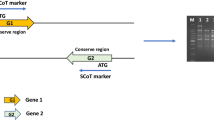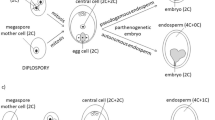Abstract
Flax (Linum usitatissimum) has a genome in which changes have been associated with environmental factors. The inbred flax variety, Stormont Cirrus (Pl), served as the parent, and several lines (termed genotrophs) were derived from this parent. The phenotypes of the genotrophs were stable in a number of different growth environments, unlike the original Pl line in which changes associated with environmental factors continued to occur. These genotrophs differed from the original line in a number of characteristics, but the only known phenotypic characteristic that is shared by all the genotrophs and different from the parental, Pl, line is the lack of changes associated with the original environmental factors. However, some of these genotrophs have changed in both phenotype and nuclear DNA subsequent to their original growth and differentiation from Pl. Representational difference analysis (RDA) has been used to identify differences between Pl and all the genotrophs in an attempt to identify the loci controlling these aspects of plasticity. Subtractions between Pl DNA as a tester (target) and one of the genotrophs (individual RDA) or a mixture of different types of genotroph (L6, S6, C2, and LH) DNAs as a driver were done (combined sample RDA; csRDA). In addition, contrary RDA, where of the genotroph DNA was used as a tester and Pl DNA as a driver, was also executed. Three difference clones (163-4-2, 123-5-2, and 163-13), from 74 primary clones obtained after three rounds of subtractions with Pl DNA as tester were further characterized. In addition, 2 difference products (213-r1 and 213-r9) were characterized from contrary RDA. The clones 163-4-2 and 163-13 from the csRDA showed polymorphisms between Pl and all the genotrophs when PCR was done with primers derived from sequences of the clones, but only the clone 163-13 polymorphism was confirmed by Southern blot analysis. Four of 5 clones (163-4-2, 123-5-2, 163-13 and 213-r9) that have been characterized appear to be associated with structural changes in the DNA. From the contrary csRDA, it was observed that no clones could be recovered from subtractions between a mixture of genotrophs as a tester and Pl as a driver, and several possible explanations have been proposed.
Similar content being viewed by others
References
Blundy, K.S., Cullis, C.A. and Hepburn, A.G. 1987. Ribosomal DNA Methylation in a Flax Genotroph and a Crown Gall Tumor. Plant Mol. Biol. 8: 217-226.
Cullis, C.A. 1973. DNA differences between flax genotrophs. Nature, 243: 515-516.
Cullis, C.A., 1976. Environmentally induced changes in the ribosomal RNA cistron number in flax. Heredity 36: 73-79.
Cullis, C.A. 1977. Molecular aspects of the environmental induction of heritable changes in flax. Heredity 38: 129-154.
Cullis, C.A. 1981. Environmentally induction of heritable changes in flax: defined environments inducing changes in rDNA and peroxidase isozyme band pattern. Heredity, 47: 87-94.
Cullis, C.A. 1981a. DNA sequence organization in the flax genome. Biochim. Biophys. Acta 652: 1-15.
Cullis, C.A. 1986. Phenotypic consequences of environmentally induced changes in plant DNA. Trends Genet 2: 307-309.
Cullis, C.A. 1987. The generation of somatic and heritable variation in response to stress. Am. Nat. 130: S62-S73.
Cullis, C.A. and Cleary, W. 1986. Rapidly varying DNA sequences in flax. Can J. Genet. Cytol. 28: 252-259.
Cullis, C.A., Swami, S. and Song, Y. 1999. RAPD polymorphisms detected among the flax genotrophs. Plant Mol. Biol. 41: 795-800.
Durrant, A. 1962. The environmental induction of heritable changes in Linum. Heredity 17: 27-61.
Durrant, A. 1971. Induction and growth of flax genotrophs. Heredity 27: 277-298.
Durrant, A. and Nicholas, D.B. 1970. An unstable gene in flax. Heredity 25: 513-527.
Goldsbrough, P.B., Ellis, T.H.N. and Cullis, C.A. 1981. Organization of the 5S RNA genes in flax. Nucl. Acids Res. 9: 5895-5904.
Lisitsyn, N.A. and Wigler, M. 1994. Applications of representational difference analysis to detection of genetic lesions in cancer. Cold Spring Harbor Laboratory, Press, Plainview, NY, pp. 2-15.
Lisitsyn, N.A., Lisitsyn, N.M. and Wigler, M. 1993. Cloning the differences between two complex genomes. Science 259: 946-951.
Oh. T.J. 2000. Labile DNA sequences in flax identified by genomic mapping and combined sample representational difference analysis (csRDA). Ph.D. Thesis, Case Western Reserve University.
Oh, T.J., Gorman, M. and Cullis, C.A. 2000. RFLP and RAPD mapping in flax. Theor. Appl. Genet. 101: 590-593.
Sambrook, J., Fritsch, E.F., and Maniatis, T. 1989. Molecular cloning: A laboratory manual, 2nd ed. Cold Spring Harbor Laboratory. Plainview, NY.
Schneeberger, R.G. and Cullis, C.A., 1991. Specific DNA alterations associated with the environmental induction of heritable changes in flax. Genetics 128: 619-630.
Author information
Authors and Affiliations
Rights and permissions
About this article
Cite this article
Oh, T.J., Cullis, C.A. Labile DNA sequences in flax identified by combined sample representational difference analysis (csRDA). Plant Mol Biol 52, 527–536 (2003). https://doi.org/10.1023/A:1024838617817
Issue Date:
DOI: https://doi.org/10.1023/A:1024838617817




